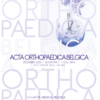Does the choice of the optic portal influence the radiographic and early functional results in acute acromioclavicular disjunctions?
shoulder; arthroscopy; acromioclavicular disjonction; surgery; surgical technique; ligament repair
Published online: Feb 17 2023
Abstract
Exposure of the coracoid process during arthroscopic stabilization of acute acromioclavicular disjunctions (ACDs) can be achieved either by passing an extra- articular optical portal through the subacromial space or by an intra-articular optical route through the glenohumeral joint with opening of the rotator interval. The objective of our study was to compare the impact on the functional results of these two optical routes. This was a retrospective, multicentre study that included patients operated on for an acute acromioclavicular disjunction arthroscopically. The treatment consisted of surgical stabilization under arthroscopy. The surgical indication was retained for an acromioclavicular disjunction of grade 3, 4 or 5, according to the Rockwood classification. Group 1, which consisted of 10 patients, was operated on with an extra-articular subacromial optical route, and group 2, which consisted of 12 patients, was operated on with an intra-articular optical route with opening of the rotator interval according to the habits of the surgeon. A follow-up of 3 months was performed. The functional results were evaluated for each patient using the Constant score, Quick DASH, and SSV. The delays in returning to professional and sports activities were also noted. A precise postoperative radiological analysis made it possible to analyse the quality of the radiological reduction. No significant difference between the two groups was found between the Constant score (88 vs. 90; p = 0.56), Quick DASH (7 vs. 7; p = 0.58), or SSV (88 vs. 93; p = 0.36). The times to return to work (6.8 weeks vs. 7.0 weeks; p = 0.54) and sports activities (15.6 weeks vs. 19.5 weeks; p = 0.53) were also comparable. The quality of the radiological reduction was satisfactory in the two groups and did not depend on the approach. No clinically or radiologically significant differences between the extra-articular and intra-articular optical portals in the surgical treatment of acute ACDs were found. The optical route can be chosen according to the habits of the surgeon.
